
Welcome to knoxvillesnakes.com! I am David, a snake enthusiast living in Knoxville, TN. Many people don't know that Knoxville is in fact full of snakes! You just need to know where to find them - they can often be shy and elusive. Some Tennessee snake species are more common outside of the city limits, in different parts of Knox County TN, but many types of snakes are indeed common in the more urban parts of Knoxville. This guide is meant to help educate you about the beautiful snakes of Knoxville, and to help you identify the most common snakes of Knoxville, as well as the venomous snakes of Knoxville that you should learn to recognize and avoid. If you want more detail, click here for my complete list of ALL snake species in Knoxville. Remember the following:
- Most snakes of Knoxville are harmless and don't want to encounter you
- Venomous snakes exist but are uncommon in Knoxville, Tennessee
- Snakes eat rats and mice and are a valuable part of the Tennessee ecosystem
- Never kill a snake - if you leave a snake alone, it will leave you alone.
Common Snake Species in Knoxville
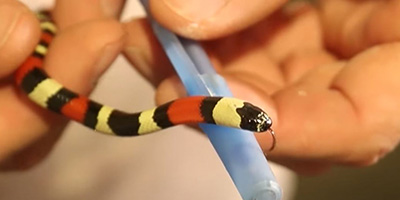 Eastern Milk Snake:
A common snake encountered in various states across America is the milk snake -which is easily identifiable due to their bright and striking colors and patterns.
Although there are instances where they are mistaken as copperheads or coral snakes, they are harmless to humans. In fact, they are a popular choice for pet owners.
Their pattern is the main reason they are confused with their rather dangerous look-alikes. They have similar blotchy colorations to the copperhead and alternating bands like the coral snake.
Eastern Milk Snake:
A common snake encountered in various states across America is the milk snake -which is easily identifiable due to their bright and striking colors and patterns.
Although there are instances where they are mistaken as copperheads or coral snakes, they are harmless to humans. In fact, they are a popular choice for pet owners.
Their pattern is the main reason they are confused with their rather dangerous look-alikes. They have similar blotchy colorations to the copperhead and alternating bands like the coral snake.
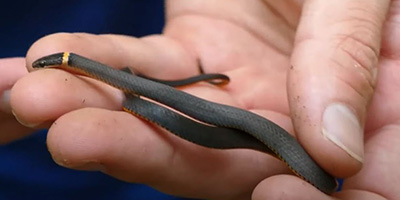 Ring Necked Snake:
It’s not often that people confuse the ring-necked snake for a different snake kind because they have one key characteristic -which is the yellow or orange band that goes around their neck.
These snakes are slender and small, reaching up to 15 inches in length. Some of the different ring-necked snakes would come with full bands or broken bands on their neck.
The ring-necked snake tends to spend more time underground or hidden under rocks, logs, or debris. Sometimes, they would be found crawling out in the open but this often happens during the night time.
Ring Necked Snake:
It’s not often that people confuse the ring-necked snake for a different snake kind because they have one key characteristic -which is the yellow or orange band that goes around their neck.
These snakes are slender and small, reaching up to 15 inches in length. Some of the different ring-necked snakes would come with full bands or broken bands on their neck.
The ring-necked snake tends to spend more time underground or hidden under rocks, logs, or debris. Sometimes, they would be found crawling out in the open but this often happens during the night time.
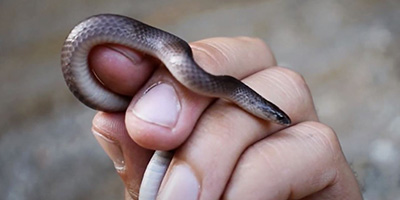 Smooth Earth Snake:
Another small snake species is the smooth earth snake, averaging at about 10 inches as an adult. However, they are quite heavy-bodied and have a pointed snout.
They are either brown or gray with small black spots scattered on their back and sides. Their belly would often be tan to a whitish color, but the color on this is not as defined as that of their sides.
They tend to hide beneath logs or debris and feed on earthworms or other soft-bodied insects around them.
Smooth Earth Snake:
Another small snake species is the smooth earth snake, averaging at about 10 inches as an adult. However, they are quite heavy-bodied and have a pointed snout.
They are either brown or gray with small black spots scattered on their back and sides. Their belly would often be tan to a whitish color, but the color on this is not as defined as that of their sides.
They tend to hide beneath logs or debris and feed on earthworms or other soft-bodied insects around them.
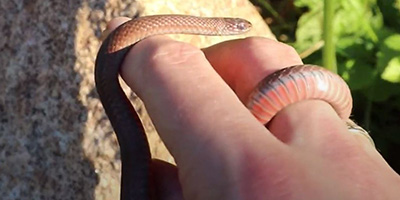 Red Bellied Snake:
The red-bellied snake goes in the same category as the smooth earth snake in terms of size, as they are similar in length.
This snake is said to be one of the most variably-colored ones as they don’t exactly come in a specific color. Because of this, they are often identified through the color of their belly instead -which is usually a bright orange or red and unmarked.
These snakes are generally secretive, therefore spending a lot of time hiding under logs, rocks, and leaf debris. Their diet is quite unique as well since they feed almost exclusively on slugs.
Red Bellied Snake:
The red-bellied snake goes in the same category as the smooth earth snake in terms of size, as they are similar in length.
This snake is said to be one of the most variably-colored ones as they don’t exactly come in a specific color. Because of this, they are often identified through the color of their belly instead -which is usually a bright orange or red and unmarked.
These snakes are generally secretive, therefore spending a lot of time hiding under logs, rocks, and leaf debris. Their diet is quite unique as well since they feed almost exclusively on slugs.
Venomous Snake Species in Knoxville
 Copperhead:
Most of the time, copperheads can get mistaken for milk snakes -which is the complete opposite of this snake because they are non-venomous instead. To tell them apart, a copperhead would have a broad, pointed head and slit pupils.
They prefer living in rocky or wooded areas that allow them to blend into the floor for having a similar color to the surrounding debris.
As they are venomous, their bites would require immediate medical attention. Compared to the rattlesnake, they don’t have mechanisms that warn passersby of their presence.
Copperhead:
Most of the time, copperheads can get mistaken for milk snakes -which is the complete opposite of this snake because they are non-venomous instead. To tell them apart, a copperhead would have a broad, pointed head and slit pupils.
They prefer living in rocky or wooded areas that allow them to blend into the floor for having a similar color to the surrounding debris.
As they are venomous, their bites would require immediate medical attention. Compared to the rattlesnake, they don’t have mechanisms that warn passersby of their presence.
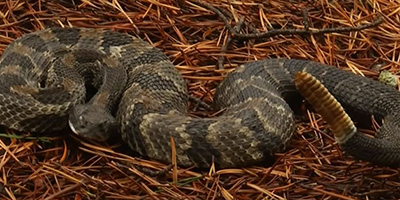 Timber Rattlesnake:
This snake is widely known for being one of the larger venomous snakes growing over 4 to 5 ft. in length.
As a member of the pit-viper family, the timber rattlesnake has a temperature-sensitive pit on both sides of its face placed somewhere between and below the eye and nostril. These are what help them locate if their prey is nearby.
They usually appear yellow, brown, or gray with black and dark brown crossbands. In some cases, they have a darker background which makes their pattern rather harder to see.
Timber Rattlesnake:
This snake is widely known for being one of the larger venomous snakes growing over 4 to 5 ft. in length.
As a member of the pit-viper family, the timber rattlesnake has a temperature-sensitive pit on both sides of its face placed somewhere between and below the eye and nostril. These are what help them locate if their prey is nearby.
They usually appear yellow, brown, or gray with black and dark brown crossbands. In some cases, they have a darker background which makes their pattern rather harder to see.
If you're unsure, you can email me a photo of the snake at info@knoxvillesnakes.com and I will email you back with the snake's species. If you found a snake skin, read my Found a Skin? page, and you can email me a photo of the skin, and I'll identify the snake for you. If you need professional Knoxville snake removal help, click my Get Help page, or see the below website sponsor I found, who provides that service.
Remember, the term is not poisonous snakes of Knoxville, it's venomous snakes of Knoxville. Poison is generally something you eat, and venom is injected into you. That said, dangerous snakes are very rare in Knoxville. The few venomous snakes of Knox County are rarely seen. But they are commonly misidentified, so learn about all the snake species of Knoxville in order to correctly identify them. These snakes are usually also found in the surrounding towns of Farragut, Mascot, Powell, Kodak, New Hopewell, Clinton, Heiskell, Seymour, Clinton, Elza, Karns, and the surrounding areas.
Read our article about:
Recent Reports Showed that Snakes Can Jump
knoxvillesnakes.com domain and hosting costs made possible by the generous support of this sponsor:
